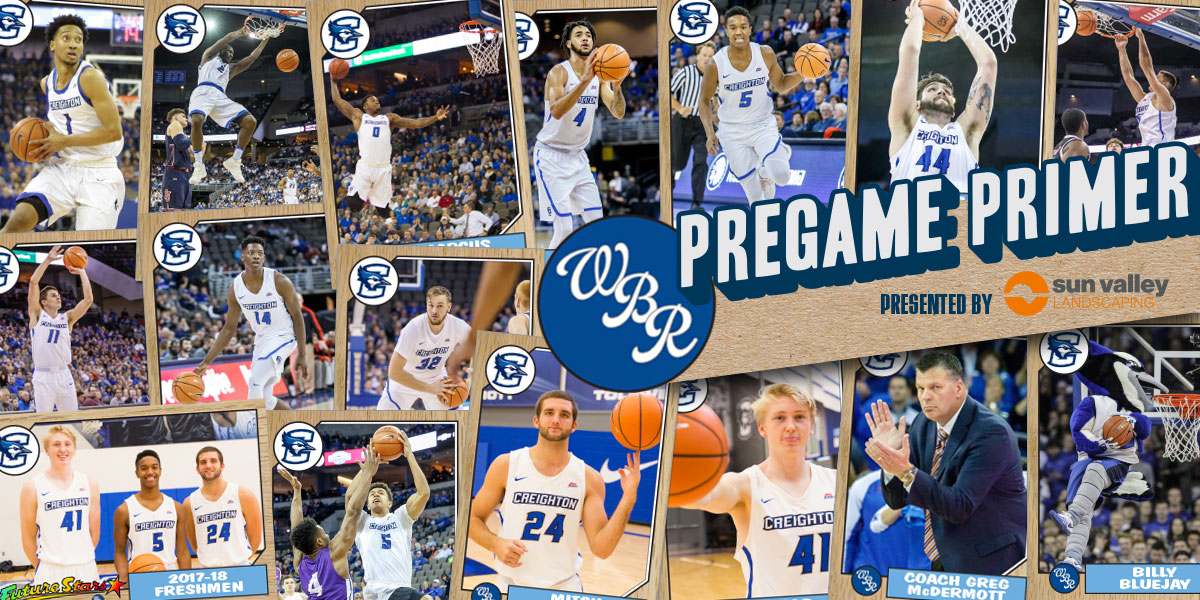Creighton begins a rugged final two weeks of the regular season on the road with a Tuesday night battle in Indianapolis against the Butler Bulldogs. The mood around the program — outside, without a doubt, and presumably inside as well — has been sour after a disappointing second half in a loss to Marquette. Greg McDermott led off his postgame press conference by saying, “To give up 49 points on our home floor in 32 possessions in the second half is a joke. If you can’t rebound and you can’t defend, you don’t deserve to win.” And later on his postgame radio interview, he hinted at changes to come.
“We have to evaluate what’s going on with the starting lineup,” McDermott said bluntly. “I’ve not been happy with the starts of our games or the starts of our second halves. We have to pinpoint what the heck is going on there. Tonight the starters were efficient offensively to start the game, but not efficient to start the second half. And they were not efficient defensively either half. This has been a reoccurring theme for three or four games, so we have to figure that out, and make a change if we need to.”
It’s been especially jarring the last two league games, both losses. Look at what the defense allowed the first five minutes of each half, and try not to cringe:
- First half vs Xavier
- Made 5 of 9 shots
- 13 points on nine possessions
- Second half vs Xavier:
- Made 5 of 8 shots
- 11 points on eight possessions
- First half vs Marquette:
- Made 7 of 8 shots
- 17 points on nine possessions
- Second half vs Marquette:
- Made 5 of 6 shots
- 12 points on seven possessions
What changes might we see to the starting lineup tonight, and will it actually make any difference beyond a superficial sense of “shaking things up”? Point guard play has been the Jays’ biggest ongoing issue, long before the loss of Martin Krampelj created one in the middle. So the most obvious (and likely) change is starting Ty-Shon Alexander at the point guard spot and bringing Davion Mintz off the bench. Maybe he gives the reigns to Kaleb Joseph and lets him either show what he can do, or prove that his small role off the bench has been warranted. Or maybe he’s really looking for a shake-up — the type of shake-up that would create an earthquake on Bluejay Twitter — and he’ll give the starting nod to Tyler Clement.
Perhaps the change he alludes to is more drastic, like starting Mitch Ballock and moving Ronnie Harrell back into the super-sub/sixth-man kind of role he excelled in before Krampelj’s injury. My best guess: Mac’s talk on Saturday was intended to light a fire under the starting unit, we’ll see the same starting five tonight, and they’ll begin both halves much more focused than they have in recent games. They have to, really. If they have another poor start to either half, they’re liable to get blown out by a Butler team who shoots far better at home than they do on the road, and has the shooters to put you in a 15 or 20 point hole that you can’t dig out of. Ask Villanova what happens when you allow Butler to get hot early.
Beyond slow starts, there’s another hot-button issue that’s been unavoidable the last two days. The Jays’ poor second half against Marquette, which coincided with the Golden Eagles switching to a 2-3 zone on defense, stoked the fire on a years-old debate. The Doug McDermott Era Bluejays famously (infamously?) struggled against zone defenses of any type. Usually, they’d make enough jump shots to force their opponent out of it eventually, but not before missing a ton of shots in a slower-tempo game than they were used to playing. But sometimes, the shots never dropped, and double-digit losses in the Big East Tournament title game or 30-point blowout losses in the NCAA Tournament were the result. Those performances, on huge stages under the bright lights of March, sealed their reputation.
Even four years after Dougie McBuckets left town, lots of college basketball followers cling to the belief that Creighton’s offense struggles mightily against a zone defense, and Bluejay fans cringe whenever an opponent shows a 2-3 or a 1-3-1 look. I’ve been guilty of it as much as anyone. But is it factual? How do the 2017-18 Bluejays really fare against the zone?
WBR’s Matt DeMarinis spent a whole lot of time yesterday with the geniuses at Synergy Sports Tech analyzing the Jays’ offense against the zone, and here’s the thing (whispering): they’re just fine. Better than fine, actually. The Jays are one of just 13 teams (out of 351) to rank in the Top 40 in points per possession against both man and zone defenses this season.
- 2014-15
- 0.849 points per possession against the zone
- D1 rank: 234th
- 1.022 points per possession against all defenses
- 0.849 points per possession against the zone
- 2015-16
- 0.997 points per possession against the zone
- D1 rank: 38th
- 1.086 points per possession against all defenses
- 0.997 points per possession against the zone
- 2016-17
- 1.035 points per possession against the zone
- D1 rank: 32nd
- 1.098 points per possession against all defenses
- 1.035 points per possession against the zone
- 2017-18
- 1.055 points per possession against the zone
- D1 rank: 31st
- 1.140 points per possession against all defenses
- 1.055 points per possession against the zone
Hmm. The numbers indicate that their reputation for struggling against the zone is residual from the 2013-14 and 2014-15 teams, and not based in fact anymore. Each of the last three years, they’ve been almost as efficient against zone defenses as they are against man-to-man schemes.
Matt dug deep into the 2017-18 Bluejays, specifically the 2017-18 Bluejays after Martin Krampelj was lost for the year — meaning the Bluejays as they are currently. Here’s how lineups with different point guards have fared:
- Lineups with Ty-Shon Alexander at point guard
- 48 possessions versus zone defenses
- 52 total points, 1.083ppp
- 14-19 on two-point shots (73.7%)
- 8-24 on three-point shots (33.3%)
- 7 team turnovers (14.6% of possessions)
- Lineups with Davion Mintz at point guard
- 46 possessions versus zone defenses
- 46 total points, 1.000ppp
- 7-20 on two-point shots (35.0%)
- 10-21 on three-point shots (47.6%)
- 2-2 on free throws (100.0%)
- 10 team turnovers (21.7% of possessions)
- Lineups with Tyler Clement at point guard
- 24 possessions versus zone defenses
- 25 total points, 1.042ppp
- 5-8 on two-point shots (62.5%)
- 5-17 on three-point shots (29.4%)
- 1 team turnover (4.2% of possessions)
- Lineups with Kaleb Joseph at point guard
- 7 possessions versus zone defenses
- 10 total points, 1.429ppp
- 2-2 on two-point shots (100.0%)
- 2-4 on three-point shots (50.0%)
- 1 team turnover (14.3% of possessions)
- Lineups with Khryi Thomas at point guard
- 4 possessions versus zone defenses
- 5 points, 1.250ppp
- 2-4 on two-point shots (50.0%)
- 0-1 on three-point shots (0.0%)
- 1-1 on free throws (100.0%)
- 1 team turnover (25.0% of possessions)
Interesting, right? They’re over one point per possession no matter who the point guard is. Throwing out the eleven possessions Joseph or Thomas were logged by Synergy as the point guard for small sample size bias, there’s some definite trends — they’re crazy efficient inside the arc with Alexander at point, have a lower turnover rate, and shoot worse from three-point range with more attempts than any other lineup. With Mintz at point, their shots are equally distributed inside and outside the arc, but they (oddly) shoot far better on three-pointers than they do on two-pointers. And they commit a lot of turnovers. With Clement, they don’t turn it over at all, and shoot twice as many threes as other shots.
Next he drilled down to a micro level and looked just at the Marquette game. There were 27 possessions against their 2-3 zone defense, and the Jays scored 27 points on those possessions. They made 5-11 on two-pointers (45.5%), 5-14 on three-pointers (35.7%), and had three turnovers. Better than you thought, likely. But what about the three point guards?
- Lineups with Tyler Clement at point guard
- 11 possessions versus Marquette’s zone
- 13 total points, 1.182ppp
- 2-5 on two-point shots
- 3-7 on three-point shots
- 0 turnovers
- Lineups with Davion Mintz at point guard
- 9 possessions versus Marquette’s zone
- 8 total points, 0.889ppp
- 0-2 on two-point shots
- 2-4 on three-point shots
- 2-2 on free throws
- 3 turnovers
- Lineups with Ty-Shon Alexander at point guard
- 7 possessions versus Marquette’s zone
- 6 points, 0.857ppp
- 3-4 on two-point shots
- 0-3 on three-point shots
- 0 turnovers
With all the focus on Jacob Epperson after the game, what about the centers?
- Lineups with Toby Hegner at center
- 69 possessions versus zone defenses
- 78 total points, 1.130ppp
- 18-29 on two-point shots (62.1%)
- 13-32 on three-point shots (40.6%)
- 3-3 on free throws (100.0%)
- 12 team turnovers (17.4% of possessions)
- Lineups with Manny Suarez at center
- 51 possessions versus zone defenses
- 47 total points, 0.922ppp
- 7-17 on two-point shots (41.2%)
- 11-33 on three-point shots (33.3%)
- 8 team turnovers (15.7% of possessions)
- Lineups with Jacob Epperson at center
- 6 possessions versus zone defenses
- 9 total points, 1.500ppp
- 3-4 on two-point shots (75.0%)
- 1-2 on three-point shots (50.0%)
- 0 team turnovers
- Lineups with Ronnie Harrell at center
- 3 possessions versus zone defenses
- 4 total points, 1.333ppp
- 2-3 on two-point shots (66.7%)
- 0 turnovers
So bringing this to its’ logical conclusion, which lineup combinations have fared best (or worst) against zone defenses? Matt analyzed that, too.
- Mintz/Foster/Thomas/Harrell/Hegner
- 23 possessions versus zone defenses
- 25 total points, 1.087ppp
- 5-11 on two-point shots (45.5%)
- 5-10 on three-point shots (50.0%)
- 5 team turnovers (21.7% of possessions)
- Clement/Foster/Thomas/Harrell/Hegner
- 12 possessions versus zone defenses
- 12 total points, 1.000ppp
- 3-6 on two-point shots (50.0%)
- 2-7 on three-point shots (28.6%)
- Alexander/Foster/Ballock/Harrell/Suarez
- 11 possessions versus zone defenses
- 13 total points, 1.182ppp
- 2-2 on two-point shots (100.0%)
- 3-8 on three-point shots (37.5%)
- 1 team turnover (9.1% of possessions)
- Alexander/Foster/Ballock/Harrell/Hegner
- 10 possessions versus zone defenses
- 17 total points, 1.700ppp
- 4-5 on two-point shots (80.0%)
- 3-5 on three-point shots (60.0%)
- 1 team turnover (10.0% of possessions)
Whether it’s against a man-to-man scheme or a zone, Creighton’s two biggest keys tonight against Butler — and in every game the rest of the way, really — are creating high-percentage shots consistently, and defensive rebounding. When they’ve done those two things, they’ve had success. When they don’t do those two things, they struggle. What did those numbers look like against Marquette?
- First half:
- 13-17 on two-point shots
- 6-10 on three-point shots
- 14-10 edge in rebounds
- 11-6 on defensive boards, giving them 11 opportunities to run in transition
- Second half:
- 8-16 on two-point shots
- 5-14 on three-point shots
- Outrebounded 23-8
- Marquette grabbed an offensive board on 9 of their 14 missed shots
Marquette’s zone defense wasn’t the problem. Certainly, the Jays’ poor defense played a role. But defensive rebounding was a massive part of it; getting crushed on the boards not only gave Marquette tons of second-chance points, it took away the Jays’ opportunities to run and score in transition.
Against Butler tonight, the Jays aren’t likely to see much zone, but they will have to contend with a Bulldog team that does a good job on the glass and doesn’t turn it over much. For the Bluejays to come out with a win, they’ll need to rebound the ball, take advantage of opportunities to score early in possessions, and begin both halves with more intensity — on both offense and defense — than they did Saturday night.
That’s an issue they may not totally be able to solve, because they just don’t have the personnel without Martin Krampelj. They gave up 14 offensive boards to Xavier and 13 to Marquette, and were outscored 41-15 in second chance points in those two games. That’s a lot to overcome. But the focus and effort that was the topic of both the postgame press conference and radio interviews after Saturday’s game can make a difference; it did in previous games without Krampelj. It will need to tonight for the Jays to win. They gave up 12 offensive boards to Butler the first time they met, and lost the rebounding battle overall despite Krampelj grabbing 14 boards by himself.

- Tip: 6:01pm
- Venue: Hinkle Fieldhouse, Indianapolis, IN
- TV: FS1
- Announcers: Tim Brando and Nick Bahe
- In Omaha: Cox channel 78 (SD), 1078 (HD); CenturyLink Prism channel 620 (SD), 1620 (HD)
- Outside Omaha: FS1 Channel Finder
- Satellite: DirecTV channel 219, Dish Network channel 150
- Streaming on FoxSportsGO
- Radio: 1620AM
- Announcers: John Bishop and Taylor Stormberg
- Streaming on 1620TheZone.com and the 1620 The Zone mobile app
- For Cord Cutters:

- Tonight is the final home game for seniors Kelan Martin and Tyler Wideman. Martin has been fantastic against everyone in the Big East except Creighton, thanks in large part to Khyri Thomas’ defense. He’s scored 20 or more points in 10 of their 15 games this year, and leads the league in scoring at 23.1 points per game in conference action. But the last two years against CU, he’s scored just 9.3 points per game. Meanwhile, Wideman averages 9.6 points and 5.2 rebounds a game, and leads the conference with a 69% shooting percentage.
- Sophomore guard Kamar Baldwin (15.6 ppg., 3.2 apg.) gives them a tremendous one-two punch in the backcourt alongside Martin, and leads the team with 46 steals. He scored 15 in the first meeting this year, making 6-16 two-point shots and 1-3 from behind the arc.
- Paul Jorgensen is Butler’s top three-point threat with 51 made treys and has 75 assists against just 24 turnovers. He led them in scoring the first time these teams met in January, logging 18 points on 8-17 shooting (including 2-6 from three-point range).
- Butler is 13-3 this season at Hinkle Fieldhouse, averaging 85.6 points per game while shooting 52 percent from the field. They’ve reached 80 points in 13 of their 16 home games, while averaging 72.3 ppg on 43-percent shooting away from home.
- The Bulldogs are +36 on points in the paint the last two games, beating up both Providence and Georgetown (36-18 vs the Friars, 48-30 vs the Hoyas). That’s a concern for the Jays tonight.

- Creighton is 7-0 this season in the game immediately after a loss, outscoring foes 87.9 – 63.6 and outrebounding the opposition 40.1 – 32.9. Marcus Foster has averaged 20.9 points per game in those contests while shooting 52.9 percent from the field and 46.2 percent from three-point land.
- Jacob Epperson scored 29 points in 26 minutes last week while making 13-of-15 shots from the floor. The true freshman had season-highs with 15 points and six rebounds on Tuesday against Bemidji State, making 6-of-8 shots. He then had 14 points in just eight minutes vs. Marquette, going 7-for-7 from the field. Epperson is the fourth Bluejay player to be perfect in seven or more attempts from the field since Greg McDermott took over in 2010, joining Geoffrey Groselle (twice), Justin Patton and Doug McDermott. Epperson is the first Bluejay to do it in a Big East game.
- Creighton has won 20 or more games in 17 of the last 19 seasons (entering 2017-18), a feat that puts the Jays among an exclusive group, nationally. CU can make it 18-of-20 seasons of 20+ wins with a victory tonight. Just three schools nationally have had 20 or more wins each of the previous 19 years: Duke, Gonzaga and Kansas. Kentucky and Florida have each done it in 18 of the previous 19 seasons.

Creighton leads the all-time series 10-6, and has won the last three matchups. They’re 3-4 in games played in Indianapolis, and 2-2 since the teams became Big East rivals.
Earlier this year, Creighton won 85-74 in Omaha, as Marcus Foster scored 23 points — 21 in a blistering first half where he made 9-14 shots — and eight assists. Martin Krampelj also had 14 points and 14 rebounds in one of his best games in what was fast becoming a breakout season. Sad face.

- During the NBA All-Star break, a pair of ex-Bluejays worked out together, as Kyle Korver and Justin Patton met up at P3 Sports Science.
- The Indy Star’s David Woods profiles the two Bulldog seniors playing their final home game tonight. It’s a good look at the bond between Kelan Martin and Tyler Wideman, and their place in Butler history.

On February 20, 2010, Creighton defeated Loyola-Chicago 78-58 at the CLink. It became a running joke on social media and message boards for years to come, as the Bluejays delayed the mandatory return game year after year, even after they switched leagues, coaches, and the BracketBuster event itself went away. Five seasons passed, and then they finally returned it with a 2015 game at Loyola.
As for the 2010 game — the most recent time Creighton’s played on this date — the Bluejays and Ramblers met in a non-televised, minimal-hype BracketBuster game that was essentially a non-conference game in the middle of February between two middling teams. A much different atmosphere than previous BracketBusters, which saw great Creighton teams square off with other great non-power conference teams in games that were often highlights of the schedule, as Ott wrote the next day:
“There was a decidedly different aura surrounding the half-full sections about 10 minutes before the opening tip. Battling dinner crowds and exiting cars from the state wrestling tournament and the home and garden show at the Qwest convention center, thousands of Jays fans sauntered to their seats with a much more laid back gait. People were excited, sure; but excited like one gets excited for an evening out that’s been planned for sometime, regardless of what is actually going on. Savvy CU fans have known for quite awhile this game would be played on a Saturday evening, something that hasn’t happened yet this season. It was bound to be an event, even if the Bluejays didn’t cooperate.
And while the Jays haven’t cooperated for most of the season — with fans’ expectations, with no doubt their own expectations, and likely those of the coaching staff as well — they played host to a fun and carefree atmosphere Saturday night. The Bluejays would lead for the first time thanks to a 3-pointer by Kenny Lawson at the 14:44 mark, and they wouldn’t trail the rest of the evening. Sure, CU gave up a 10-point lead with 4 minutes to play in the first half and took just a 1-point cushion into the locker room at intermission, but a blowout seemed inevitable.
In fact, the only people in the Qwest Center who seemed nervous, aside from the folks who turned in less than exceptional fan shoot-out efforts, were new starters Ethan Wragge and Josh Jones. Taking the spots of Casey Harriman and Darryl Ashford, respectively, the two freshmen who have given the team a boost in recent weeks were rewarded with a spot in the opening lineup.”

It’s that time of the season where we drink coffee out of a hubcap. (I’ll embed the radio edit, but the far better album version is here. Click to pop it open in a new tab.)
The Bottom Line:
KenPom favors Butler by four, and the Vegas line has steadily increased from 5.5 to 7 in favor of the Bulldogs. For a game the Jays really, really need to win, that’s not promising. But Creighton hasn’t lost two in a row all year, and I have a feeling they’ll be a little extra motivated after their collapse Saturday night. Call me crazy.
Creighton 82, Butler 78


